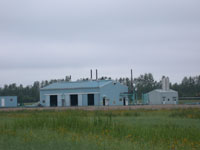Lucas Habib
 |
To date, most research on the impacts of oil and gas development in Alberta has focused on wildlife response to physical damage to the environment. However, habitat available to wildlife may also be reduced as a result of high background noise levels emanating from industrial installations. For example, there are over 3000 compressor stations in Alberta, each of which emits constant noise at levels of about 75 to 90 dB, a level which has been correlated with reduced abundance of forest birds along highways. This effect is possibly due to interference with mating song transmission or elevated stress levels. Mammals such as deer and moose have also been shown to avoid highways, possibly as a result of noise. Starting in 2003, I have been surveying bird communities in the summer months, to evaluate abundance, mating success, and blood stress levels at varying distances from compressor stations. Beginning in winter 2004, I will to snow-track mammals around compressor stations to determine whether chronic background noise results in a zone of avoidance around compressor stations. Ultimately, I plan to create a series of cost-benefit models examining how noise reduction could potentially reduce habitat loss.

I grew up in Ottawa and majored in Wildlife Biology at the University of Guelph (2002). In the past, Iíve done contract wildlife jobs in Canada, the United States, and New Zealand, including work with martens and endangered birds.
|
Last Modified:2003-10-27 |